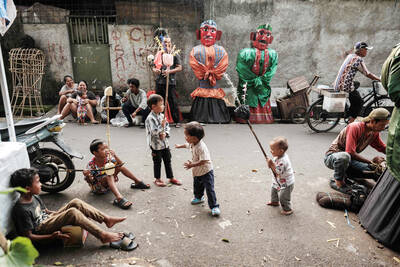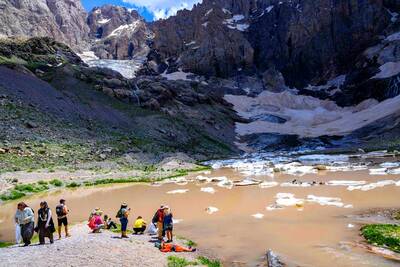A night of rioting in protest against the fatal shooting of a 16-year-old boy by policemen left parts of central Athens littered with the debris of smashed and burned, but not looted, businesses.
At 5am yesterday morning, Ermou Street, near Syntagma Square, the Greek capital’s heart, was still busy with revelers leisurely strolling toward the square’s metro station, about to open for the day. It was a couple blocks down from the Syntagma end of the street that the damage began.
In a three-block section of this shopping street, where real estate and rents are among the most expensive in Europe, there were at least 21 damaged shops. Most had their storefront windows smashed and blackened by the heat of firebombs, in stark contrast with the intact displays of clothes further inside the shops, highlighted by expertly placed lighting designed to attract the shoppers.
Many shops had doors blown away and left wide open.
One of the three blocks was closed to strollers as firefighters were still battling a blaze that had left a three-story emporium a blackened skeleton with a barely standing, smoking roof.
The strange reality of people calmly strolling through the damage, their shoes creaking against the pieces of strewn glass, was highlighted by the acrid smell of tear gas used in large quantities by the police a few hours before to drive the rioters away, a slight haze still hanging in the air and the repetitive sound of alarms that drew little attention.
The riots that engulfed Athens on Saturday night, spreading to Greece’s second-largest city of Thessaloniki and at least five other provincial towns, were the most serious since January 1991. Then, two large department stores were burned, one of them together with four people who had mistakenly chosen its entrance as a hiding place, by firebomb-throwing crowd protesting the slaying of a left-wing school teacher at the hands of right-wing thugs. During this protest time, there were no fatalities, or even serious injuries.
Witnesses said the shooting of the boy occurred at about 9pm when a small group of youths attacked a police patrol car.
A police officer fired three shots, hitting the teenager in the chest. Witness accounts diverge widely over what happened.
Several hours after the incident, police issued a statement saying the patrol car, with two officers inside, was attacked by a group of 30 stone-throwing youths while patrolling the central district of Exarchia.
The casualties of the riot included both large multinationals’ outlets, such as H&M and Benetton, and small shops whose owners were already feeling the pinch of the economic downturn before they were faced with expensive repairs that they will have to undertake to get their businesses up and running again.
In some ways, the destruction was not indiscriminate. While clothing shops — the majority of Ermou Street outlets — and banks were heavily damaged, the numerous snack bars were all left intact and, even at 5am, they were full of customers.
A few blocks north of Syntagma Square, at Akadimias Street, another main Athens thoroughfare, the rioters had almost totally destroyed the bus stops and ticket kiosks used daily by hundreds of thousands of commuters in what is one of the city’s major transport hubs. A few of the rioters — almost all of them self-styled anarchists — were still there, a few still masked to camouflage themselves and some armed with steel pipes and warily eyeing the riot police that were camped two blocks further ahead, holding shields and with gas masks dangling from their necks.
The police, and the Athenians, were bracing for possible further rioting later yesterday. It was feared that a protest march in favor of illegal immigrants, which will end at police headquarters and which had been scheduled several days ahead, would be infiltrated by elements eager to do further battle with police and damage to property.

In the sweltering streets of Jakarta, buskers carry towering, hollow puppets and pass around a bucket for donations. Now, they fear becoming outlaws. City authorities said they would crack down on use of the sacred ondel-ondel puppets, which can stand as tall as a truck, and they are drafting legislation to remove what they view as a street nuisance. Performances featuring the puppets — originally used by Jakarta’s Betawi people to ward off evil spirits — would be allowed only at set events. The ban could leave many ondel-ondel buskers in Jakarta jobless. “I am confused and anxious. I fear getting raided or even

Kemal Ozdemir looked up at the bare peaks of Mount Cilo in Turkey’s Kurdish majority southeast. “There were glaciers 10 years ago,” he recalled under a cloudless sky. A mountain guide for 15 years, Ozdemir then turned toward the torrent carrying dozens of blocks of ice below a slope covered with grass and rocks — a sign of glacier loss being exacerbated by global warming. “You can see that there are quite a few pieces of glacier in the water right now ... the reason why the waterfalls flow lushly actually shows us how fast the ice is melting,” he said.

RISING RACISM: A Japanese group called on China to assure safety in the country, while the Chinese embassy in Tokyo urged action against a ‘surge in xenophobia’ A Japanese woman living in China was attacked and injured by a man in a subway station in Suzhou, China, Japanese media said, hours after two Chinese men were seriously injured in violence in Tokyo. The attacks on Thursday raised concern about xenophobic sentiment in China and Japan that have been blamed for assaults in both countries. It was the third attack involving Japanese living in China since last year. In the two previous cases in China, Chinese authorities have insisted they were isolated incidents. Japanese broadcaster NHK did not identify the woman injured in Suzhou by name, but, citing the Japanese

RESTRUCTURE: Myanmar’s military has ended emergency rule and announced plans for elections in December, but critics said the move aims to entrench junta control Myanmar’s military government announced on Thursday that it was ending the state of emergency declared after it seized power in 2021 and would restructure administrative bodies to prepare for the new election at the end of the year. However, the polls planned for an unspecified date in December face serious obstacles, including a civil war raging over most of the country and pledges by opponents of the military rule to derail the election because they believe it can be neither free nor fair. Under the restructuring, Myanmar’s junta chief Min Aung Hlaing is giving up two posts, but would stay at the